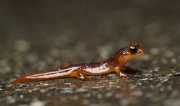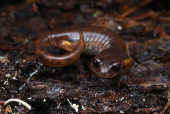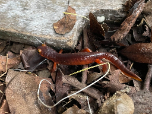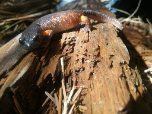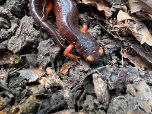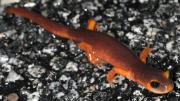Ensatinas (Ensatina eschscholtzii)
Description: A small, brown or orangish salamander with large dark eyes, and relatively short body and legs. Adults are 1.5 to 3 inches total length. The tail is rounded in cross section and a prominent constriction exists at the base near the body. There are 12 to 13 costal grooves.
Juveniles are dark brown with bright orange patches on the tops of the limbs near the body. Young juveniles have a silvery metal-flake pattern on a dark background on the body, but they lose this pattern rapidly as they increase in size.
Males have an enlarged upper lip and long, slender tails. Females have short, stout tails. Ensatina is the only Washington salamander with a constriction at the base of the tail. The tailbase constriction is difficult to see in young juveniles, but these individuals consistently possess the bright orange patches on top of the limbs near the body.
Habitat: In the northern part of its distribution, this species can be found in Douglas-fir/maple forests and forest clearings. In coastal areas, it inhabits redwood forest, chaparral, oak woodland, canyons. In the Sierra Nevada, habitats include pine-oak-incense cedar forests. In dry or cold weather, these salamanders stay in caves, underground, or in or under rotting logs. The subspecies Ensatina eschscholtzii klauberi lives in mixed conifer forest and lays its eggs on the ground. It is unclear as to whether or not it is tolerant of habitat disturbance.
Range: This species occurs from southwestern British Columbia in Canada, south through the Coastal Ranges of the United States of America to extreme northwestern Baja California and the Sierra San Pedro Martir and Sierra Juárez in Mexico; and along the western slopes of Cascade Range and Sierra Nevada in California in the USA. It is absent from Sacramento-San Joaquin valley, California. It occurs as a large number of subspecies. It occurs at elevations between sea level and about 3,350 meters above sea level.
Found in these States:
AZ |
CA |
OR |
WA
Diet: Ensatinas eat small spiders, beetles, worms, snails, and various other organisms. They spot their prey and exhibit crouching/stalking behavior. With their protruding tongues, they capture their prey and bring it into the mouth.
Reproduction: Eggs are laid underground, or under the bark of or within rotting logs, where they develop directly without a larval stage.
Status: Listed as Least Concern in view of the large extent of occurrence, large number of subpopulations and localities, and presumed large population size.
»» Kingdom: Animalia - Animals
»» Phylum: Chordata - Chordates
»» Subphylum: Vertebrata - Vertebrates
»» Class: Amphibia - (Amphibians)
»» Order: Caudata - Salamanders
»» Family: Plethodontidae - Lungless Salamanders
»» Genus: Ensatina
»» Species: Ensatina eschscholtzii - Ensatina
This article uses material from the Wikipedia article "Ensatina", which is released under the Creative Commons Attribution-Share-Alike License 3.0. Content may have been omitted from the original, but no content has been changed or extended.
|


